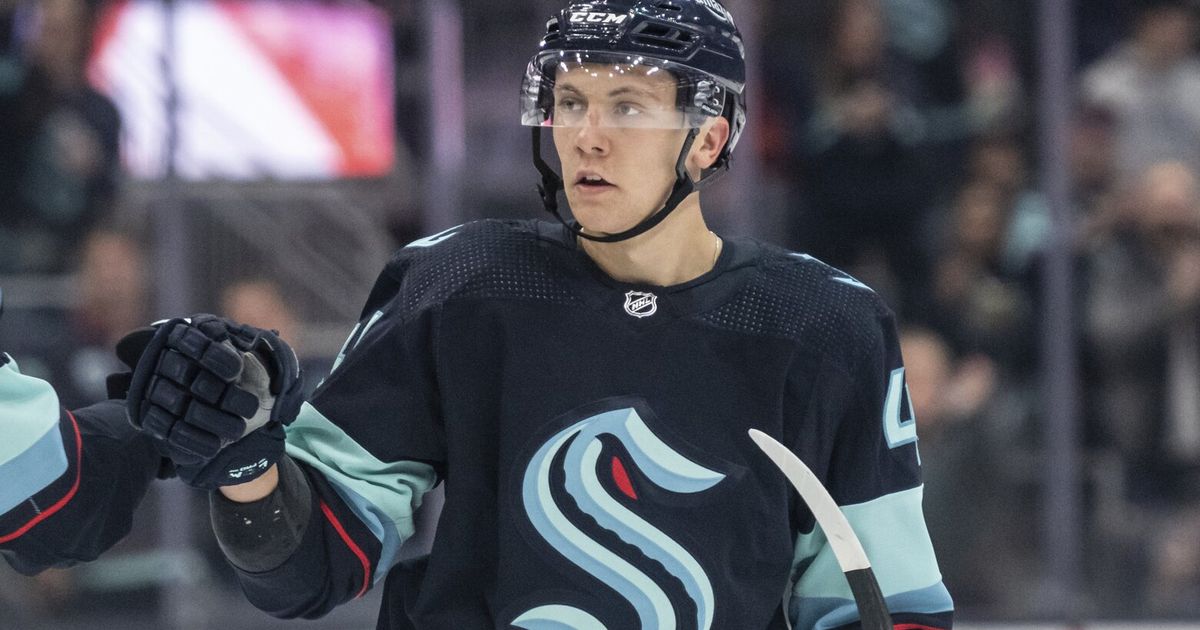
Inside the NHL
Seeing new Kraken defenseman Justin Schultz out running the power play in the team’s preseason opener shouldn’t really have surprised.
Coach Dave Hakstol clearly used Monday night’s game against the Edmonton Oilers to deploy newer faces in envisioned roles. Holdovers such as Yanni Gourde, Jordan Eberle, Jaden Schwartz, Jared McCann and Vince Dunn were known commodities and could wait until Tuesday, unlike Schultz and others Hakstol is still evaluating.
By using more newcomers in the opener, including forwards Oliver Bjorkstrand, Andre Burakovsky and rookie Matty Beniers, Hakstol will have additional time to make corrections or changes before the regular season begins Oct. 12 in Anaheim, California.
There are few areas more important than the power play, for which Hakstol needs to get ideas aligned with reality. The aforementioned Bjorkstrand, Burakovsky and Beniers — the “Killer B’s,” if you will — were part of Monday night’s main power-play unit, so Hakstol got a good look at all in five-on-five and man-advantage situations.
Sure, the Kraken weren’t great at penalty killing, either, last season. But that group at least had some positive stretches. The fizzling power play was a seasonlong ordeal that unsurprisingly ran in concert with a poor overall offensive showing.
The Kraken were fourth-worst in power-play proficiency at 14.55% compared with the NHL average of 20.61% and fourth-worst in overall goals with 213. But they were fifth-worst in even-strength goals with 152, so a quick fix for overall offensive output would be to capitalize more with the man advantage.
And if you’re going to fix a power play, the guy running it needs to be at the top of his game. That’s where the “quarterback” term gets applied to the lone defenseman on the typical power-play unit — one who sits atop the 1-3-1 formation and guides play depending on how opposing penalty killers react in front of him.
You need a defenseman boasting offensive skills and quick thinking. Last season the Kraken used captain Mark Giordano as the primary power-play quarterback until he was traded in March, and the role fell into Dunn’s lap almost by default.
Dunn was the only other Kraken defender with above-average offensive ability, one reason the team struggled at times to quickly exit the zone and pounce on opponents’ turnovers. And when the Kraken went looking this summer for another defenseman in free agency, the 32-year-old Schultz loomed as a potentially undervalued commodity because of power-play ability never fully utilized.
“There’s a great opportunity here,” Schultz said before Monday’s opener. “A lot of young, talented players. Very skilled.”
And though the Kraken went 0-for-6 with the man advantage facing the Oilers, they threw the puck around better as the game progressed. They should have had a goal late when Bjorkstrand’s shot hit Wennberg on the way into a vacated net, and nearly had another on an early one-timer by Beniers.
Schultz saw power-play time with the Pittsburgh Penguins and Washington Capitals in recent seasons. But the Penguins had Kris Letang, and the Capitals deployed John Carlson as their primary power-play quarterbacks — two standouts who made it tough for Schultz to get opportunities.
The Kraken sensed that Schultz could have far more to offer had he not been blocked. That opinion was bolstered by Kraken assistant general manager Jason Botterill having seen Schultz up close during his time in Pittsburgh’s front office.
Schultz said he learned plenty from watching Letang and Carlson.
“Just the way they run it,” he said. “They’re both so poised and not afraid to take a shot when it’s there. They’ve been doing it a long time, and so those power plays have been two of the best in the league for a while, and that’s where we want to be.”
It’s difficult to tell how much of last season’s Kraken power-play struggles were due to the quarterbacking vs. overall personnel. Giordano and Dunn weren’t exactly throwing the puck around to superstars Sidney Crosby and Evgeni Malkin the way Schultz’s teammate Letang has with Pittsburgh for years.
As for Dunn, still only 25 and a restricted free agent after this season, he had his ups and downs with the rest of the team during a difficult 2021-22 campaign. The Kraken hope to see Dunn, likely to be on the top blue-line pairing at even strength, take a bigger step in his progression.
And lessening the pressure of Dunn having to run the primary power-play unit could help in that regard.
Dunn is also a left-handed shot; Schultz shoots from the right. The Kraken have sorely missed a right handed D-man who can drive offense from the left point position on power plays and — at the very least — allow for quicker, more accurate feeds for one-timed shots by Beniers from the right circle, as happened Monday.
Hakstol said of Schultz: “He’s done it for a long time in this league at a high level. He’s real good up top — great poise, great vision.”
That said, Hakstol was careful not to place too much importance on the role Schultz is being considered to fill.
“It’s not about one player,” he said. “It’s about a group collectively. Finding chemistry and doing a good job.”
Given those words, it’s telling that of the five primary power-play guys Monday night, only Wennberg was a full-season regular on the previous Kraken team.
It’s possible the Kraken could move a forward, or perhaps even two, into the main power-play unit from the primary group assigned to Tuesday night’s game against Calgary — which featured Dunn, McCann, Eberle, Schwartz and first-round draft pick Shane Wright.
But either way, this is looking to be a significant specialty teams overhaul from one season to the next with a new guy leading it. Which was a needed switch for a Kraken squad in which the football option of declining a penalty has often seemed preferable to them trying to capitalize on one.